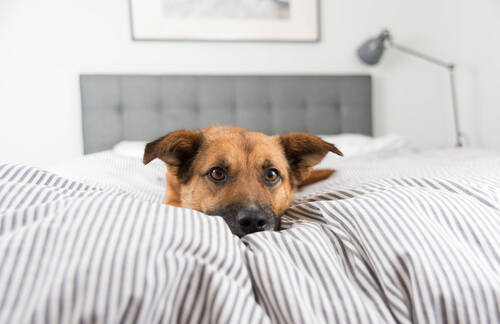Why Can't Dogs Sleep on the Bed?

Any excuse is good enough to let a pet sleep with us. But is it a good idea? Or a bad one? We are going to tell you in this article why dogs can’t sleep on the bed (or at least why they shouldn’t).
Dogs can’t sleep on the bed?
In reality, there is no law that prohibits it, however, it wouldn’t be very recommended. Sleeping with your pet on the bed can be a bad decision. Maybe not at the beginning when he is small, but it is later, when he grows up… Maybe not when you live alone, but it is when you move in with your significant other… It could be okay when the dog is clean, but not so much if he came back from the park all muddy.

Letting the dog sleep with us can interrupt our sleep (which we really need) if he moves around a lot, has nightmares, or barks at every sound he hears. Also, it could prevent you from sleeping in on the weekends. Remember that he will lick you when he wants to go out and do his business…
All of that, and we haven’t even mentioned what happens when it’s hot outside. The animal, with all his fur and own body heat, will turn your bed into an oven. Even more so if he’s one of those that sleeps clinging to you.
More and more people sleep with their dog
It’s very curious that a third of the population that has pets recognizes that they treat them as if they were small children. And it’s also amazing that they take photos of them as if they were our children. Not to mention the fact that they have permission to sleep in the bed with their owners, no matter their age or size (of the bed and the dog).
So, what are the risks or negative consequences of sleeping with pets (dogs in particular)?
1. Health problems
Dogs are home to a large number of microorganisms that cannot be seen. For example, bacteria, fungi, dust, etc. When they go outside, they sniff everything that appears in front of them or they do their business. Mites in hair or skin particles can cause allergies at any age, and will be more dangerous in the case of allergic people. You also run the risk of contracting some illness caused by a parasite (like fleas or ticks).
Furthermore, while he sleeps, the dog can scratch us and cause an infection in the wound. It is worth remembering that those with a weakened immune system, pregnant women, small children, and the elderly are more prone to suffer from diseases caused by pets if they sleep with them in bed.
2. Sleep problems
Although it seems strange, the best way to rest is sleeping alone. And this includes people and animals. If you don’t have another room to sleep apart from your significant other, at least don’t let your dog climb up on the bed. The snoring, nightmares, and movements of the other being next to us can impact the quality of our sleep. This is even more evident in those that have sleep problems, suffer from insomnia, or are light sleepers.

We shouldn’t forget about the fact that animals and people have different body temperatures that go down at night. Maybe in the winter, it’s very nice to sleep with your dog because he brings you warmth. But remember, in summer you won’t want to have your furry friend close.
3. Behavior problems
If you still aren’t convinced that dogs can’t sleep in the bed, you should think a little about how the animal can suffer due to your decision. Maybe you think you’re doing a good thing by letting him on the bed, however, this is not the case. Dogs that sleep with their owners can be more aggressive, insecure, anxious, and depressed. In addition, they can want to mark their territory by urinating on the sheets.
Finally, you mustn’t forget the marital or family problems that your decision could lead to. Lack of intimacy or space could cause arguments. After having read all of this, do you think that dogs can sleep on the bed or not?
All cited sources were thoroughly reviewed by our team to ensure their quality, reliability, currency, and validity. The bibliography of this article was considered reliable and of academic or scientific accuracy.
- Dotson, M. J., & Hyatt, E. M. (2008). Understanding dog–human companionship. Journal of Business Research, 61(5), 457-466.
- McCONNELL, P. B. (2006). Al otro extremo de la correa.
- Rooney, N. J., Bradshaw, J. W., & Robinson, I. H. (2000). A comparison of dog–dog and dog–human play behaviour. Applied Animal Behaviour Science, 66(3), 235-248.
- Rugaas, T., & Ramos, B. P. (2005). El lenguaje de los perros: las señales de calma. Kns ediciones.